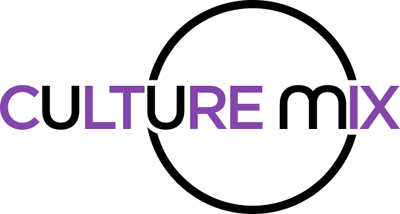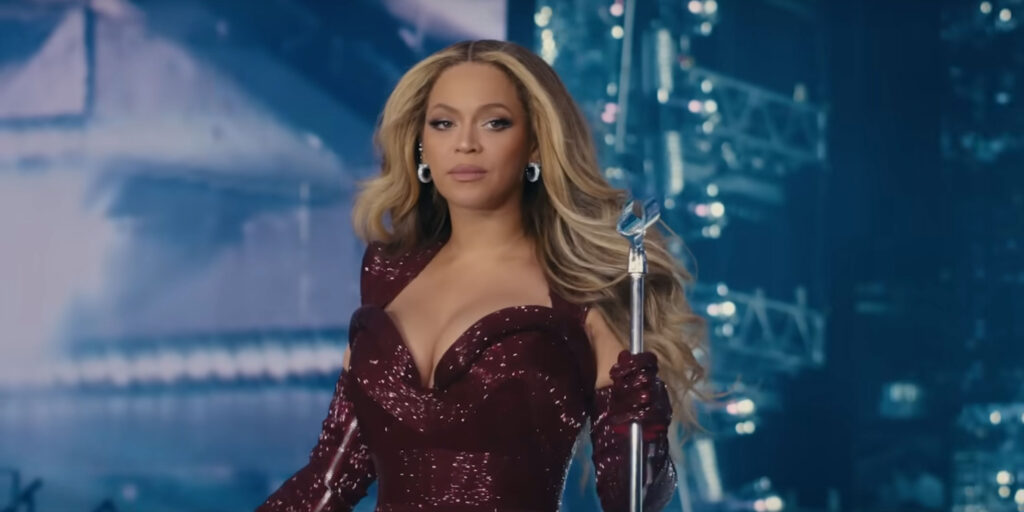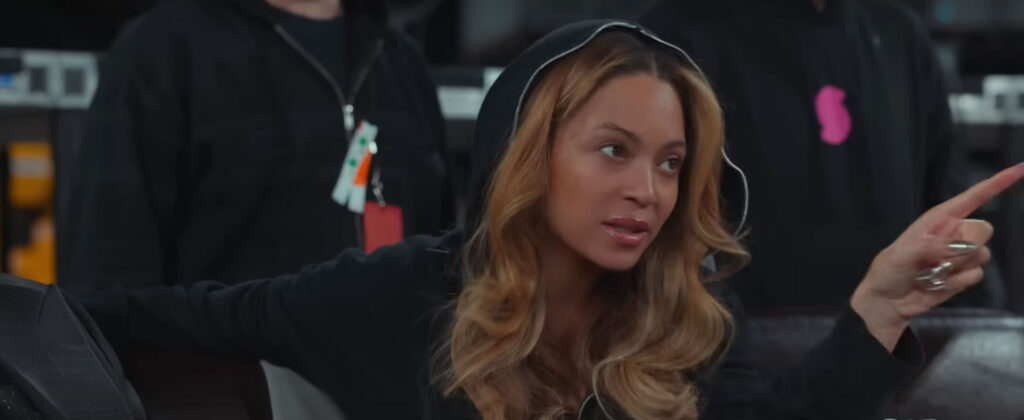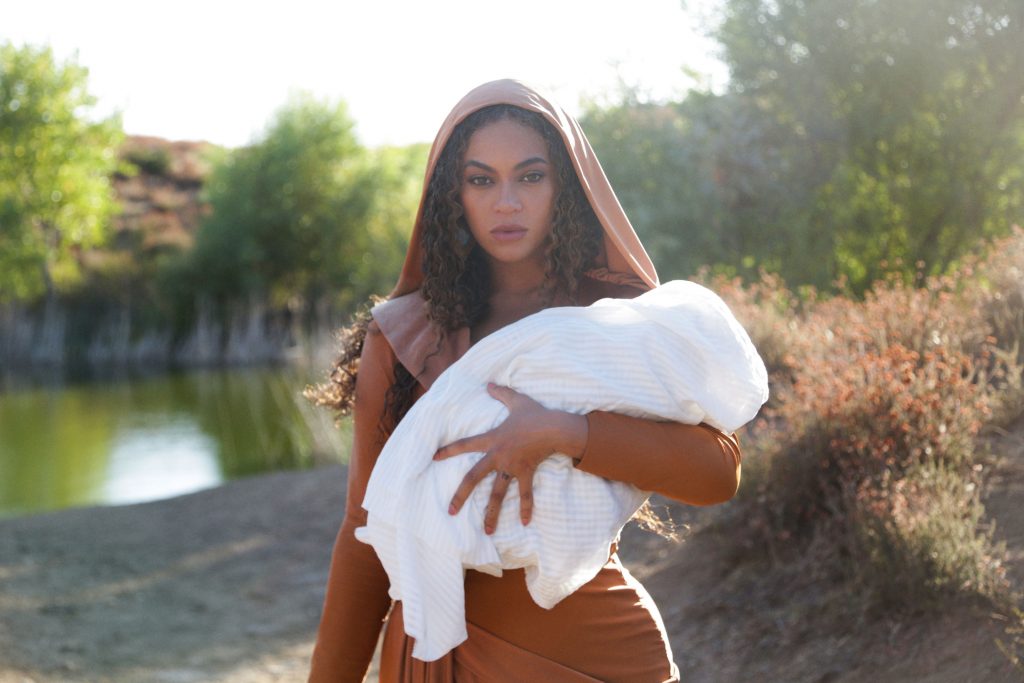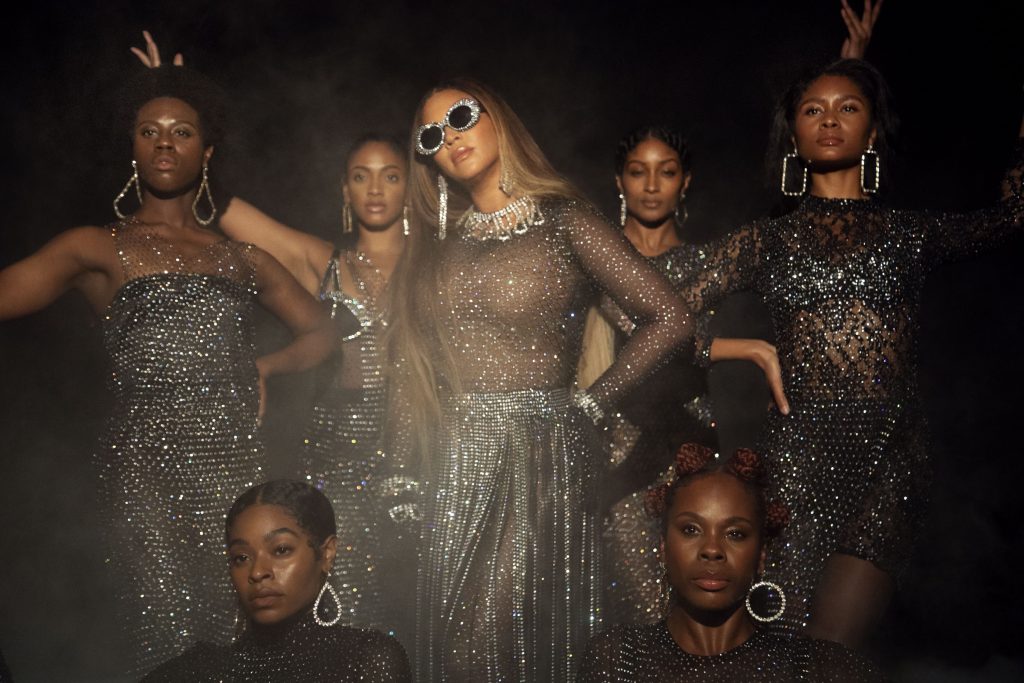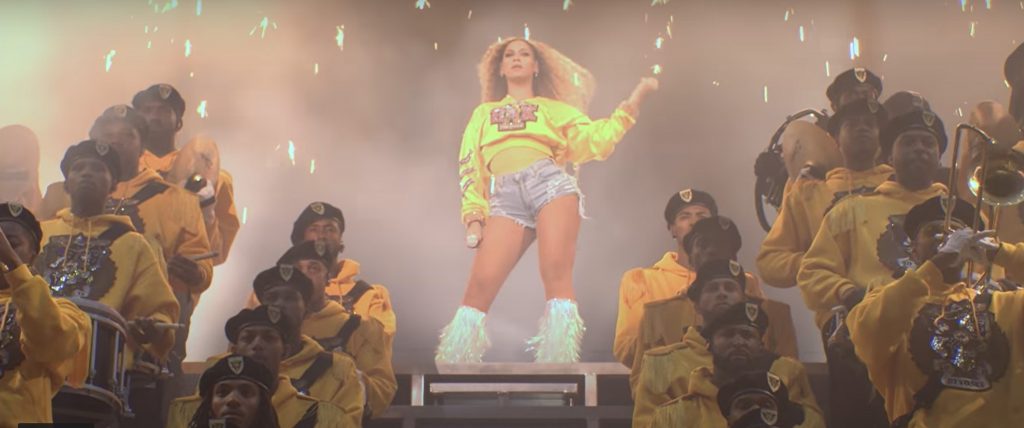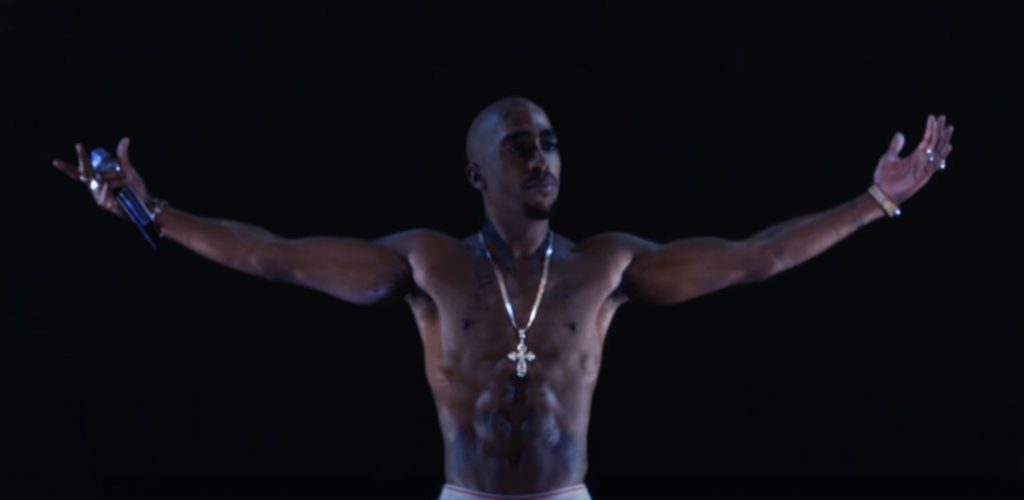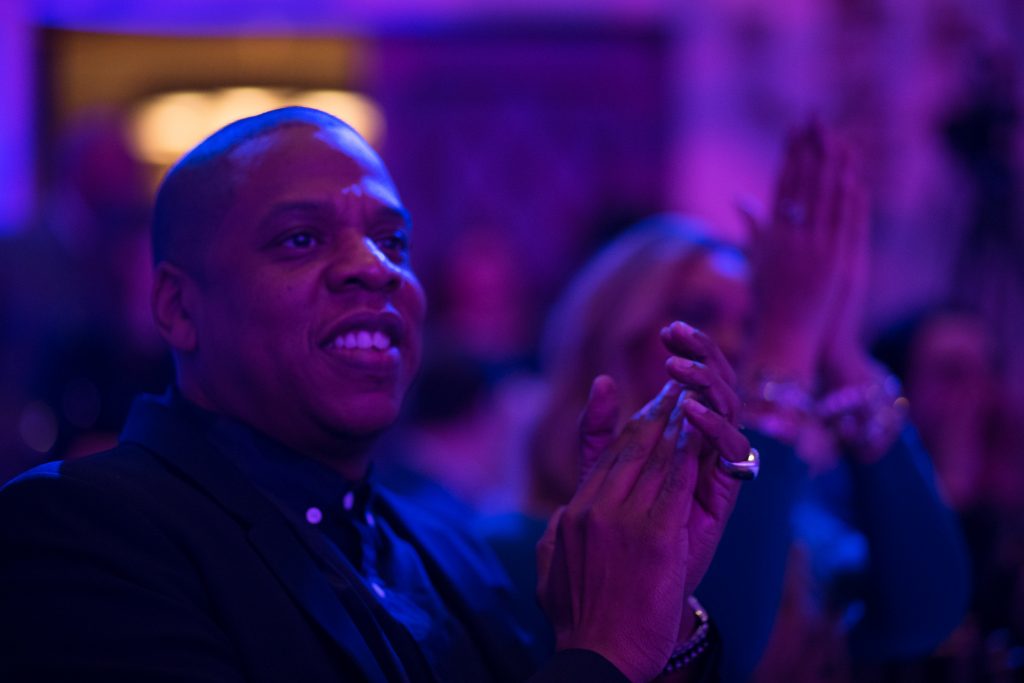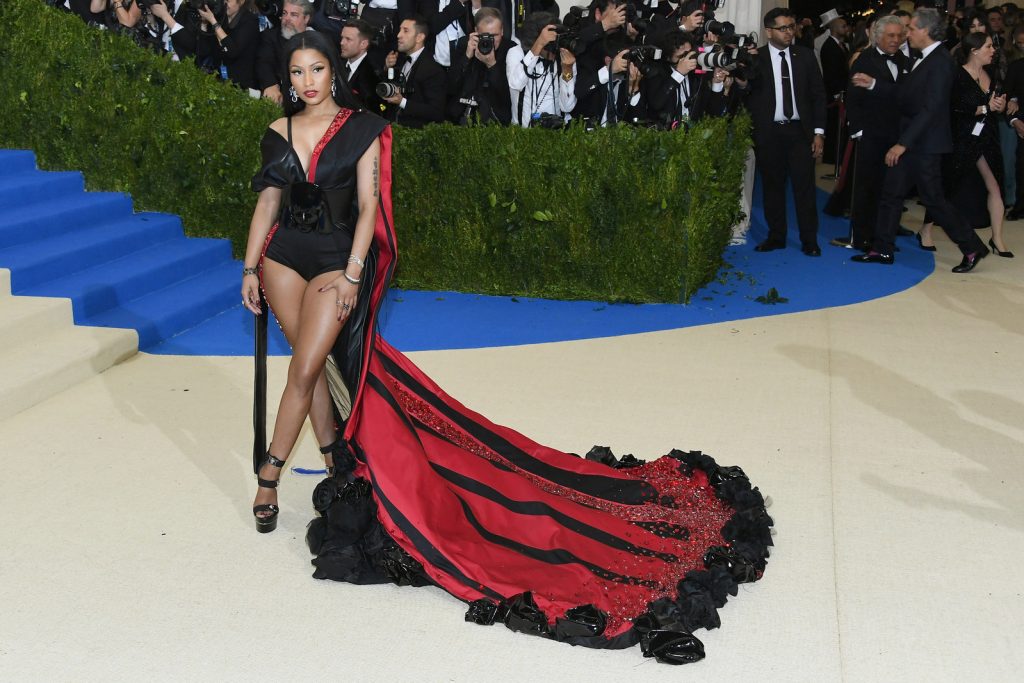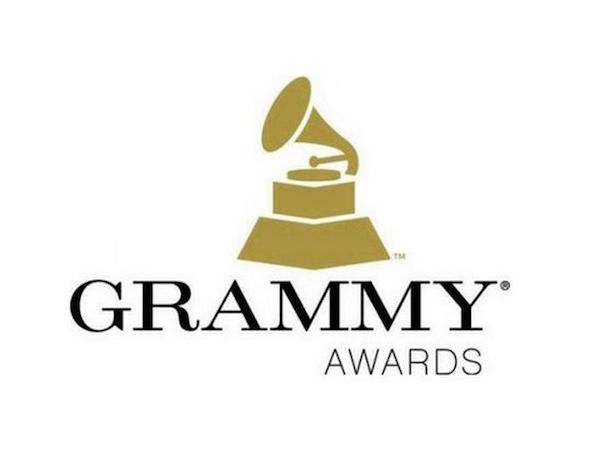February 4, 2024
by Carla Hay
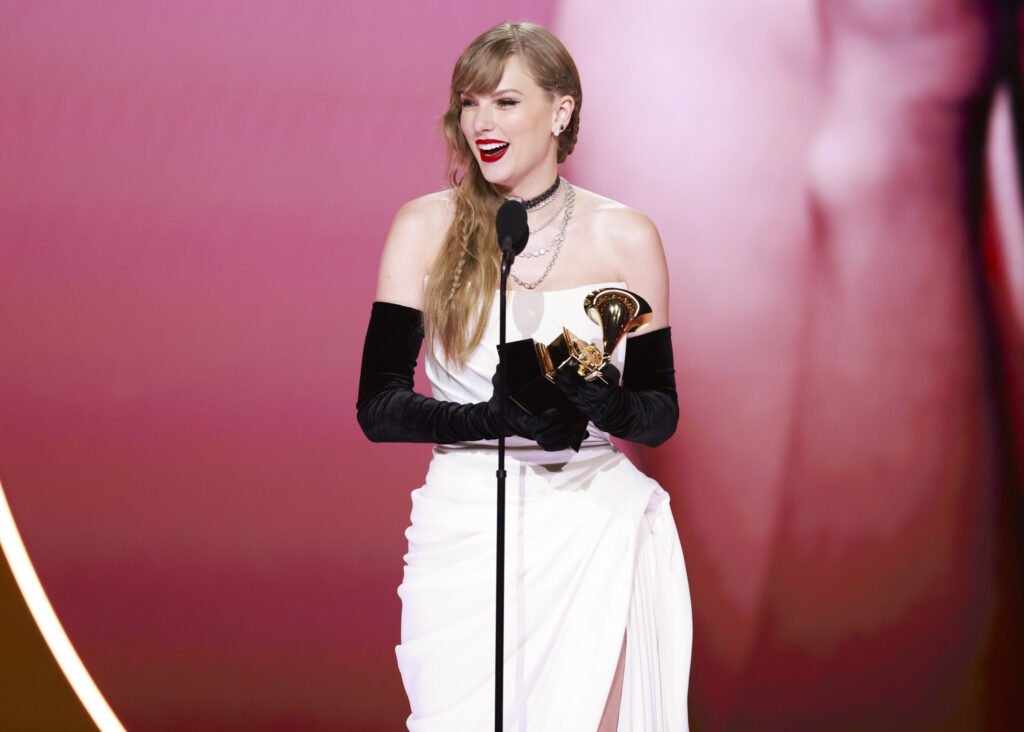
Taylor Swift, Miley Cyrus, Billie Eilish, SZA were among the big winners at the 66th annual Grammy Awards, which were presented at the Crypto.com Arena in Los Angeles on February 4, 2024. Trevor Noah hosted the Grammy Awards for the fourth consecutive year. CBS had the live U.S. telecast of the ceremony, which was livestreamed on Paramount+ With Showtime. Several of the Grammy categories were presented in a pre-telecast ceremony that was livestreamed on Grammy.com.
Swift’s “Midnights” won Album of the Year and Best Pop Vocal Album. She now holds the records as the person who has won Album of the Year the most times (four.) at the Grammy Awards. There was no artist at the show who dominated by winning more than three awards. Miley Cyrus won Record of the Year and Best Pop Solo Performance for “Flowers.” Billie Eilish and her brother/songwriting partner Finneas O’Connell won Song of the Year and Best Song Written for Visual Media for “What Was I Made For?” from the “Barbie” soundtrack.
SZA (whose real name is Solána Rowe) had the most nominations (nine) going into the ceremony. She won three Grammys at the show: Best Progressive R&B Album, for “SOS”; Best Pop Duo/Group Performance, for her “Ghost in the Machine” collaboration with Phoebe Bridgers; and Best R&B Song, for “Snooze.” SZA performed “Snooze” and “Kill Bill” at the show. Victoria Monét, who had seven nominations going into the ceremony, also won three Grammys: Best R&B Album (for “Jaguar II”), Best New Artist, and Best Engineered Album, Non-Classical (for “Jaguar II”).
Jay-Z received the Dr. Dre Global Impact Award, which was first given in 2023 to Dr. Dre. The Recording Academy’s Black Music Collective gives this noncompetitive prize to influential people in black music. During his acceptance speech, Jay-Z (whose real name is Shawn Carter) was joined on stage by his and wife Beyoncé’s eldest child, 12-year-old daughter Blue Ivy Carter, while Beyoncé watched at their table.
In his memorable speech, Jay-Z talked about being one of the hip-hop artists who boycotted the Grammys for overlooking hip-hop, such as the Grammys not putting the rap categories on television (which happened again this year) or not nominating certain rap artists in the years that they had successful albums. Jay-Z also gave some criticism for Beyoncé not winning a Grammy for Album of the Year, even though she holds the record for being the person who’s won the most Grammys (32), which was a record that she attained in 2023.
Jay-Z added when commenting about who gets awarded (or not) at the Grammys: “ “I’m saying, we want you to get it right. At least close to getting it right. Obviously, it’s subjective. It’s music, and it’s opinion-based … Some of you will go home tonight and will feel like you’ve been robbed. Some of you may get robbed. Some of you don’t belong in the category.” After hearing a mixture of booing and laughter at that last remark, he said, “When I get nervous, I tell the truth.”
He concluded his speech by saying, “Outside of that, we’ve got to keep showing up. Forget the Grammys for a second—just in life … you’ve got to keep showing up … until they give you all those accolades you feel you deserve, until they call you chairman, until they call you genius, until they call you the greatest of all time.”
Artists who performed at the show included Dua Lipa, Cyrus and Olivia Rodrigo. U2 performed remotely from the Sphere in Paradise, Nevada. On-stage collaborations included Luke Combs with Tracy Chapman; Travis Scott with Playboi Carti; and Burna Boy with 21 Savage and Brandy.
Joni Mitchell performed at the Grammys for the first time. She sang “Both Sides Now” and was joined on stage for the performance by Brandi Carlile, SistaStrings, Blake Mills, Lucius, Allison Russell and Jacob Collier.
Stevie Wonder, Annie Lennox, Jon Batiste and Fantasia Barrino did separate performances for the “In Memoriam” segment that paid tribute to notable people in the music industry who died since the previous Grammy ceremony. Billy Joel performed “Turn the Lights Back On,” his first new song in 30 years, and closed out the show with his 1980 hit “You May Be Right.”
Celine Dion made a surprise appearance to present the award for Album of the Year. Other presenters at the show were Oprah Winfrey, Meryl Streep, Mark Ronson, Mariah Carey, Lenny Kravitz, Lionel Richie, U2, Lizzo, Christina Aguilera, Maluma, Samara Joy, Brandi Carlile and Kacey Musgraves.
Here is the complete list of nominees and winners for the 2024 Grammy Awards:
*=winner
General Field
1. Record Of The Year
Award to the Artist and to the Producer(s), Recording Engineer(s) and/or Mixer(s) and mastering engineer(s), if other than the artist.
Worship
Jon Batiste
Jon Batiste, Jon Bellion, Pete Nappi & Tenroc, producers; Serban Ghenea & Pete Nappi, engineers/mixers; Chris Gehringer, mastering engineer
Not Strong Enough
boygenius
boygenius & Catherine Marks, producers; Owen Lantz, Catherine Marks, Mike Mogis, Bobby Mota, Kaushlesh “Garry” Purohit & Sarah Tudzin, engineers/mixers; Pat Sullivan, mastering engineer
Flowers*
Miley Cyrus
Kid Harpoon & Tyler Johnson, producers; Michael Pollack, Brian Rajaratnam & Mark “Spike” Stent, engineers/mixers; Joe LaPorta, mastering engineer
What Was I Made For? [From The Motion Picture “Barbie”]
Billie Eilish
Billie Eilish & FINNEAS, producers; Billie Eilish, Rob Kinelski & FINNEAS, engineers/mixers; Chris Gehringer, mastering engineer
On My Mama
Victoria Monét
Deputy, Dernst Emile II & Jeff Gitelman, producers; Patrizio Pigliapoco & Todd Robinson, engineers/mixers; Colin Leonard, mastering engineer
Vampire
Olivia Rodrigo
Dan Nigro, producer; Serban Ghenea, Michael Harris, Chris Kasych, Daniel Nigro & Dan Viafore, engineers/mixers; Randy Merrill, mastering engineer
Anti-Hero
Taylor Swift
Jack Antonoff & Taylor Swift, producers; Jack Antonoff, Serban Ghenea, Laura Sisk & Lorenzo Wolff, engineers/mixers; Randy Merrill, mastering engineer
Kill Bill
SZA
Rob Bisel & Carter Lang, producers; Rob Bisel, engineer/mixer; Dale Becker, mastering engineer
2. Album Of The Year
Award to Artist(s) and to Featured Artist(s), Songwriter(s) of new material, Producer(s), Recording Engineer(s), Mixer(s) and Mastering Engineer(s) credited with 20% or more playing time of the album.
World Music Radio
Jon Batiste
Jon Batiste, Jon Bellion, Nick Cooper, Pete Nappi & Tenroc, producers; Jon Batiste, Pete Nappi, Kaleb Rollins, Laura Sisk & Marc Whitmore, engineers/mixers; Jon Batiste, Jon Bellion, Jason Cornet & Pete Nappi, songwriters; Chris Gehringer, mastering engineer
the record
boygenius
boygenius & Catherine Marks, producers; Owen Lantz, Will Maclellan, Catherine Marks, Mike Mogis, Bobby Mota, Kaushlesh “Garry” Purohit & Sarah Tudzin, engineers/mixers; Julien Baker, Phoebe Bridgers & Lucy Dacus, songwriters; Pat Sullivan, mastering engineer
Endless Summer Vacation
Miley Cyrus
Kid Harpoon, Tyler Johnson & Mike Will Made-It, producers; Pièce Eatah, Craig Frank, Paul David Hager, Stacy Jones, Brian Rajaratnam & Mark “Spike” Stent, engineers/mixers; Miley Cyrus, Gregory Aldae Hein, Thomas Hull, Tyler Johnson, Michael Len Williams II & Michael Pollack, songwriters; Joe LaPorta, mastering engineer
Did You Know That There’s A Tunnel Under Ocean Blvd
Lana Del Rey
Jack Antonoff, Zach Dawes, Lana Del Rey & Drew Erickson, producers; Jack Antonoff, Michael Harris, Dean Reid & Laura Sisk, engineers/mixers; Jack Antonoff, Lana Del Rey & Mike Hermosa, songwriters; Ruairi O’Flaherty, mastering engineer
The Age Of Pleasure
Janelle Monáe
Sensei Bueno, Nate “Rocket” Wonder & Nana Kwabena, producers; Mick Guzauski, Nate “Rocket” Wonder, Jayda Love, Janelle Monáe & Yáng Tan, engineers/mixers; Jarrett Goodly, Nathaniel Irvin III, Janelle Monáe Robinson & Nana Kwabena Tuffuor, songwriters; Dave Kutch, mastering engineer
GUTS
Olivia Rodrigo
Daniel Nigro, producer; Serban Ghenea, Sterling Laws, Mitch McCarthy, Daniel Nigro, Dave Schiffman, Mark “Spike” Stent, Sam Stewart & Dan Viafore, engineers/mixers; Daniel Nigro & Olivia Rodrigo, songwriters; Randy Merrill, mastering engineer
Midnights*
Taylor Swift
Jack Antonoff & Taylor Swift, producers; Jack Antonoff, Zem Audu, Serban Ghenea, David Hart, Mikey Freedom Hart, Sean Hutchinson, Ken Lewis, Michael Riddleberger, Laura Sisk & Evan Smith, engineers/mixers; Jack Antonoff & Taylor Swift, songwriters; Randy Merrill, mastering engineer
SOS
SZA
Rob Bisel, ThankGod4Cody & Carter Lang, producers; Rob Bisel, engineer/mixer; Rob Bisel, Cody Fayne, Carter Lang & Solána Rowe, songwriters; Dale Becker, mastering engineer
3. Song Of The Year
A Songwriter(s) Award. A song is eligible if it was first released or if it first achieved prominence during the Eligibility Year. (Artist names appear in parentheses.) Singles or Tracks only.
A&W
Jack Antonoff, Lana Del Rey & Sam Dew, songwriters (Lana Del Rey)
Anti-Hero
Jack Antonoff & Taylor Swift, songwriters (Taylor Swift)
Butterfly
Jon Batiste & Dan Wilson, songwriters (Jon Batiste)
Dance The Night (From Barbie The Album)
Caroline Ailin, Dua Lipa, Mark Ronson & Andrew Wyatt, songwriters (Dua Lipa)
Flowers
Miley Cyrus, Gregory Aldae Hein & Michael Pollack, songwriters (Miley Cyrus)
Kill Bill
Rob Bisel, Carter Lang & Solána Rowe, songwriters (SZA)
Vampire
Daniel Nigro & Olivia Rodrigo, songwriters (Olivia Rodrigo)
What Was I Made For? [From The Motion Picture “Barbie”]*
Billie Eilish O’Connell & Finneas O’Connell, songwriters (Billie Eilish)
4. Best New Artist
This category recognizes an artist whose eligibility-year release(s) achieved a breakthrough into the public consciousness and notably impacted the musical landscape.
Gracie Abrams
Fred again..
Ice Spice
Jelly Roll
Coco Jones
Noah Kahan
Victoria Monét*
The War And Treaty
5. Producer Of The Year, Non-Classical
A Producer’s Award. (Artists names appear in parentheses.)
Jack Antonoff*
• Being Funny In A Foreign Language (The 1975) (A)
• Did You Know That There’s A Tunnel Under Ocean Blvd (Lana Del Rey) (A)
• Midnights (Taylor Swift) (A)
Dernst “D’Mile” Emile II
• JAGUAR II (Victoria Monét) (A)
Hit-Boy
• Bus Stop (Don Toliver Featuring Brent Faiyaz) (T)
• Just Face It (Dreamville With Blxst) (T)
• Kings Disease III (Nas) (A)
• Magic 3 (Nas) (A)
• Magic 2 (Nas) (A)
• Slipping Into Darkness (Hit-Boy & The Alchemist) (S)
• Surf Or Drown Vol. 1 (Hit-Boy) (A)
• Surf Or Drown Vol. 2 (Hit-Boy) (A)
• Victims & Villains (Musiq Soulchild & Hit-Boy) (A)
• Metro Boomin
• Am I Dreaming (Metro Boomin Featuring Roisee & A$AP Rocky) (S)
• Calling (Metro Boomin Featuring NAV, A Boogie Wit Da Hoodie & Swae Lee) (S)
• Creepin’ (Metro Boomin Featuring 21 Savage & The Weeknd) (S)
• More M’s (Drake & 21 Savage) (S)
• Oh U Went (Young Thug Featuring Drake) (S)
• Superhero (Heroes & Villains) (Metro Boomin, Future & Chris Brown) (S)
• Til Further Notice (Travis Scott Featuring James Blake & 21 Savage) (S)
• Trance (Metro Boomin Featuring Travis Scott & Young Thug) (S)
• War Bout It (Lil Durk Featuring 21 Savage) (S)
• Daniel Nigro
• Casual (Chappell Roan) (S)
• Divide (Dermot Kennedy) (S)
• Guts (Olivia Rodrigo) (A)
• Hot To Go! (Chappell Roan) (S)
• Kaleidoscope (Chappell Roan) (S)
• Red Wine Supernova (Chappell Roan) (S)
• Welcome To My Island (Caroline Polachek) (S)
6. Songwriter of the Year, Non-Classical
A Songwriter’s Award. (Artists names appear in parentheses.)
Edgar Barrera
• Cuestion De Tiempo (Don Omar) (T)
• Falsa Alarma (En Vivo) (Grupo Firme) (T)
• Gucci Los Paños (Karol G) (T)
• La Despedida (Christian Nodal) (T)
• Mi Ex Tenía Razón (Karol G) (T)
• Que Vuelvas (Various Artists) (T)
• Un Cumbión Dolido (Christian Nodal) (T)
• un x100to (Grupo Frontera & Bad Bunny) (T)
• Yo Pr1mero (Rels B) (S)
Jessie Jo Dillon
• Buried (Brandy Clark) (T)
• Girl In The Mirror (Megan Moroney) (T)
• Halfway To Hell (Jelly Roll) (T)
• I Just Killed A Man (Catie Offerman) (S)
• Memory Lane (Old Dominion) (S)
• Neon Cowgirl (Dan + Shay) (T)
• screen (HARDY) (T)
• The Town In Your Heart (Lori McKenna) (T)
• Up Above The Clouds (Cecilia’s Song) (Brandy Clark) (T)
Shane McAnally
• Come Back To Me (Brandy Clark) (S)
• Good With Me (Walker Hayes) (S)
• He’s Never Gunna Change (Lauren Daigle) (S)
• I Should Have Married You (Old Dominion) (S)
• Independently Owned (Alex Newell & Original Broadway Cast of Shucked) (S)
• Never Grow Up (Niall Horan) (S)
• Start Nowhere (Sam Hunt) (S)
• Walmart (Sam Hunt) (S)
• We Don’t Fight Anymore (Carly Pearce & Chris Stapleton) (S)
Theron Thomas*
• All My Life (Lil Durk Featuring J. Cole) (S)
• Been Thinking (Tyla) (S)
• Cheatback (Chlöe & Future) (T)
• How We Roll (Ciara & Chris Brown) (S)
• Make Up Your Mind (Cordae) (S)
• Pretty Girls Walk (Big Boss Vette) (S)
• Seven (Jung Kook & Latto) (S)
• Told Ya (Chlöe & Missy Elliot) (T)
• You And I (Sekou) (T)
Justin Tranter
• Gemini Moon (Reneé Rapp) (T)
• Honey! (Are U Coming?) (Måneskin) (S)
• I Want More (Marisa Davila & Cast Of Grease: Rise Of The Pink Ladies) (S)
• Jersey (Baby Tate) (S)
• A Little Bit Happy (TALK) (S)
• Pretty Girls (Reneé Rapp) (S)
• River (Miley Cyrus) (S)
Field 1: Pop & Dance/Electronic Music
7. Best Pop Solo Performance
For new vocal or instrumental pop recordings. Singles or Tracks only.
Flowers*
Miley Cyrus
Paint The Town Red
Doja Cat
What Was I Made For? [From The Motion Picture “Barbie”]
Billie Eilish
Vampire
Olivia Rodrigo
Anti-Hero
Taylor Swift
8. Best Pop Duo/Group Performance
For new vocal or instrumental duo/group or collaborative pop recordings. Singles or Tracks only.
Thousand Miles
Miley Cyrus Featuring Brandi Carlile
Candy Necklace
Lana Del Rey Featuring Jon Batiste
Never Felt So Alone
Labrinth Featuring Billie Eilish
Karma
Taylor Swift Featuring Ice Spice
Ghost In The Machine*
SZA Featuring Phoebe Bridgers
9. Best Pop Vocal Album
For albums containing greater than 75% playing time of new pop vocal recordings.
Chemistry
Kelly Clarkson
Endless Summer Vacation
Miley Cyrus
GUTS
Olivia Rodrigo
– (Subtract)
Ed Sheeran
Midnights*
Taylor Swift
10. Best Dance/Electronic Recording
For solo, duo, group or collaborative performances. Vocal or Instrumental. Singles or tracks only.
Blackbox Life Recorder 21F
Aphex Twin
Richard D James, producer; Richard D James, mixer
Loading
James Blake
James Blake & Dom Maker, producers; James Blake, mixer
Higher Than Ever Before
Disclosure
Cirkut, Guy Lawrence & Howard Lawrence, producers; Guy Lawrence, mixer
Strong
Romy & Fred again..
Fred again.., Stuart Price & Romy, producers; Fred again.. & Stuart Price, mixers
Rumble*
Skrillex, Fred again.. & Flowdan
Fred again.. & Skrillex, producers; Skrillex, mixer
11. Best Pop Dance Recording
For solo, duo, group or collaborative performances. Vocal or Instrumental. Singles or tracks only.
Baby Don’t Hurt Me
David Guetta, Anne-Marie & Coi Leray
Johnny Goldstein, Toby Green, David Guetta & Mike Hawkins, producers; Serban Ghenea, mixer
Miracle
Calvin Harris Featuring Ellie Goulding
Burns & Calvin Harris, producers; Calvin Harris, mixer
Padam Padam*
Kylie Minogue
Lostboy, producer; Guy Massey, mixer
One In A Million
Bebe Rexha & David Guetta
Burns & David Guetta, producers; Serban Ghenea, mixer
Rush
Troye Sivan
Styalz Fuego, Novodor & Zhone, producers; Alex Ghenea, mixer
12. Best Dance/Electronic Music Album
For vocal or instrumental albums. Albums only.
Playing Robots Into Heaven
James Blake
For That Beautiful Feeling
The Chemical Brothers
Actual Life 3 (January 1 – September 9 2022)*
Fred again..
Kx5
Kx5
Quest For Fire
Skrillex
Field 2: Rock, Metal & Alternative Music
13. Best Rock Performance
For new vocal or instrumental solo, duo/group or collaborative rock recordings.
Sculptures Of Anything Goes
Arctic Monkeys
More Than A Love Song
Black Pumas
Not Strong Enough*
Boygenius
Rescued
Foo Fighters
Lux Æterna
Metallica
14. Best Metal Performance
For new vocal or instrumental solo, duo/group or collaborative metal recordings.
Bad Man
Disturbed
Phantom Of The Opera
Ghost
72 Seasons*
Metallica
Hive Mind
Slipknot
Jaded
Spiritbox
15. Best Rock Song
A Songwriter(s) Award. Includes Rock, Hard Rock and Metal songs. A song is eligible if it was first released or if it first achieved prominence during the Eligibility Year. (Artist names appear in parentheses.) Singles or Tracks only.
Angry
Mick Jagger, Keith Richards & Andrew Watt, songwriters (The Rolling Stones)
Ballad Of A Homeschooled Girl
Daniel Nigro & Olivia Rodrigo, songwriters (Olivia Rodrigo)
Emotion Sickness
Dean Fertita, Joshua Homme, Michael Shuman, Jon Theodore & Troy Van Leeuwen, songwriters (Queens Of The Stone Age)
Not Strong Enough*
Julien Baker, Phoebe Bridgers & Lucy Dacus, songwriters (boygenius)
Rescued
Dave Grohl, Rami Jaffee, Nate Mendel, Chris Shiflett & Pat Smear, songwriters (Foo Fighters)
16. Best Rock Album
For albums containing greater than 75% playing time of new rock, hard rock or metal recordings.
But Here We Are
Foo Fighters
Starcatcher
Greta Van Fleet
72 Seasons
Metallica
This Is Why*
Paramore
In Times New Roman…
Queens Of The Stone Age
17. Best Alternative Music Performance
For new vocal or instrumental solo, duo/group or collaborative Alternative music recordings.
Belinda Says
Alvvays
Body Paint
Arctic Monkeys
Cool About It
boygenius
A&W
Lana Del Rey
This Is Why*
Paramore
18. Best Alternative Music Album
Vocal or Instrumental.
The Car
Arctic Monkeys
The Record*
boygenius
Did You Know That There’s A Tunnel Under Ocean Blvd
Lana Del Rey
Cracker Island
Gorillaz
I Inside The Old Year Dying
PJ Harvey
Field 3: R&B, Rap & Spoken Word Poetry
19. Best R&B Performance
For new vocal or instrumental R&B recordings.
Summer Too Hot
Chris Brown
Back To Love
Robert Glasper Featuring SiR & Alex Isley
ICU*
Coco Jones
How Does It Make You Feel
Victoria Monét
Kill Bill
SZA
20. Best Traditional R&B Performance
For new vocal or instrumental traditional R&B recordings.
Simple
Babyface Featuring Coco Jones
Lucky
Kenyon Dixon
Hollywood
Victoria Monét Featuring Earth, Wind & Fire & Hazel Monét
Good Morning*
PJ Morton Featuring Susan Carol
Love Language
SZA
21. Best R&B Song
A Songwriter(s) Award. A song is eligible if it was first released or if it first achieved prominence during the Eligibility Year. (Artist names appear in parentheses.) Singles or Tracks only.
Angel
Halle Bailey, Theron Feemster & Coleridge Tillman, songwriters (Halle)
Back To Love
Darryl Andrew Farris, Robert Glasper & Alexandra Isley, songwriters (Robert Glasper Featuring SiR & Alex Isley)
ICU
Darhyl Camper Jr., Courtney Jones, Raymond Komba & Roy Keisha Rockette, songwriters (Coco Jones)
On My Mama
Dernst Emile II, Jeff Gitelman, Victoria Monét, Kyla Moscovich, Jamil Pierre & Charles Williams, songwriters (Victoria Monét)
Snooze*
Kenny B. Edmonds, Blair Ferguson, Khris Riddick-Tynes, Solána Rowe & Leon Thomas, songwriters (SZA)
22. Best Progressive R&B Album
For albums containing greater than 75% playing time of newly recorded progressive vocal tracks derivative of R&B.
Since I Have A Lover
6LACK
The Love Album: Off The Grid
Diddy
Nova
Terrace Martin And James Fauntleroy
The Age Of Pleasure
Janelle Monáe
SOS*
SZA
23. Best R&B Album
For albums containing greater than 75% playing time of new R&B recordings.
Girls Night Out
Babyface
What I Didn’t Tell You (Deluxe)
Coco Jones
Special Occasion
Emily King
JAGUAR II*
Victoria Monét
CLEAR 2: SOFT LIFE EP
Summer Walker
24. Best Rap Performance
For a Rap performance. Singles or Tracks only.
The Hillbillies
Baby Keem Featuring Kendrick Lamar
Love Letter
Black Thought
Rich Flex
Drake & 21 Savage
SCIENTISTS & ENGINEERS*
Killer Mike Featuring André 3000, Future And Eryn Allen Kane
Players
Coi Leray
25. Best Melodic Rap Performance
For a solo or collaborative performance containing both elements of R&B melodies and Rap.
Sittin’ On Top Of The World
Burna Boy Featuring 21 Savage
Attention
Doja Cat
Spin Bout U
Drake & 21 Savage
All My Life*
Lil Durk Featuring J. Cole
Low
SZA
26. Best Rap Song
A Songwriter(s) Award. A song is eligible if it was first released or if it first achieved prominence during the Eligibility Year. (Artist names appear in parentheses.) Singles or Tracks only.
Attention
Rogét Chahayed, Amala Zandile Dlamini & Ari Starace, songwriters (Doja Cat)
Barbie World [From Barbie The Album]
Isis Naija Gaston, Ephrem Louis Lopez Jr. & Onika Maraj, songwriters (Nicki Minaj & Ice Spice Featuring Aqua)
Just Wanna Rock
Mohamad Camara, Symere Woods & Javier Mercado, songwriters (Lil Uzi Vert)
Rich Flex
Brytavious Chambers, Isaac “Zac” De Boni, Aubrey Graham, J. Gwin, Anderson Hernandez, Michael “Finatik” Mule & Shéyaa Bin Abraham-Joseph, songwriters (Drake & 21 Savage)
SCIENTISTS & ENGINEERS*
Andre Benjamin, Paul Beauregard, James Blake, Michael Render, Tim Moore & Dion Wilson, songwriters (Killer Mike Featuring André 3000, Future And Eryn Allen Kane)
27. Best Rap Album
For albums containing greater than 75% playing time of new rap recordings.
Her Loss
Drake & 21 Savage
MICHAEL*
Killer Mike
HEROES & VILLIANS
Metro Boomin
King’s Disease III
Nas
UTOPIA
Travis Scott
28. Best Spoken Word Poetry Album
For albums containing greater than 50% playing time of new spoken word poetry recordings.
A-You’re Not Wrong B-They’re Not Either: The Fukc-It Pill Revisited
Queen Sheba
For Your Consideration’24 -The Album
Prentice Powell and Shawn William
Grocery Shopping With My Mother
Kevin Powell
The Light Inside*
J. Ivy
When The Poems Do What They Do
Aja Monet
Field 4: Jazz, Traditional Pop, Contemporary Instrumental & Musical Theater
29. Best Jazz Performance
For new vocal or instrumental solo, duo/group or collaborative jazz recordings.
Movement 18′ (Heroes)
Jon Batiste
Basquiat
Lakecia Benjamin
Vulnerable (Live)
Adam Blackstone Featuring The Baylor Project & Russell Ferranté
But Not For Me
Fred Hersch & Esperanza Spalding
Tight*
Samara Joy
30. Best Jazz Vocal Album
For albums containing greater than 75% playing time of new vocal jazz recordings.
For Ella 2
Patti Austin Featuring Gordon Goodwin’s Big Phat Band
Alive At The Village Vanguard
Fred Hersch & Esperanza Spalding
Lean In
Gretchen Parlato & Lionel Loueke
Mélusine
Cécile McLorin Salvant
How Love Begins*
Nicole Zuraitis
31. Best Jazz Instrumental Album
For albums containing greater than 75% playing time of new instrumental jazz recordings.
The Source
Kenny Barron
Phoenix
Lakecia Benjamin
Legacy: The Instrumental Jawn*
Adam Blackstone
The Winds Of Change*
Billy Childs
Dream Box
Pat Metheny
32. Best Large Jazz Ensemble Album
For albums containing greater than 75% playing time of new ensemble jazz recordings.
The Chick Corea Symphony Tribute – Ritmo
ADDA Simfònica, Josep Vicent, Emilio Solla
Dynamic Maximum Tension
Darcy James Argue’s Secret Society
Basie Swings The Blues*
The Count Basie Orchestra Directed By Scotty Barnhart
Olympians
Vince Mendoza & Metropole Orkest
The Charles Mingus Centennial Sessions
Mingus Big Band
33. Best Latin Jazz Album
For vocal or instrumental albums containing greater than 75% playing time of newly recorded material. The intent of this category is to recognize recordings that represent the blending of jazz with Latin, Iberian-American, Brazilian, and Argentinian tango music.
Quietude
Eliane Elias
My Heart Speaks
Ivan Lins With The Tblisi Symphony Orchestra
Vox Humana
Bobby Sanabria Multiverse Big Band
Cometa
Luciana Souza & Trio Corrente
El Arte Del Bolero Vol. 2*
Miguel Zenón & Luis Perdomo
34. Best Alternative Jazz Album
For vocal or instrumental albums containing greater than 75% playing time of new Alternative jazz recordings.
Love In Exile
Arooj Aftab, Vijay Iyer, Shahzad Ismaily
Quality Over Opinion
Louis Cole
SuperBlue: The Iridescent Spree
Kurt Elling, Charlie Hunter, SuperBlue
Live At The Piano
Cory Henry
The Omnichord Real Book*
Meshell Ndegeocello
35. Best Traditional Pop Vocal Album
For albums containing greater than 75% playing time of new traditional pop recordings.
To Steve With Love: Liz Callaway Celebrates Sondheim
Liz Callaway
Pieces Of Treasure
Rickie Lee Jones
Bewitched*
Laufey
Holidays Around The World
Pentatonix
Only The Strong Survive
Bruce Springsteen
Sondheim Unplugged (The NYC Sessions), Vol. 3
(Various Artists)
36. Best Contemporary Instrumental Album
For albums containing greater than 75% playing time of new contemporary instrumental recordings.
As We Speak*
Béla Fleck, Zakir Hussain, Edgar Meyer, Featuring Rakesh Chaurasia
On Becoming
House Of Waters
Jazz Hands
Bob James
The Layers
Julian Lage
All One
Ben Wendel
37. Best Musical Theater Album
For albums containing greater than 51% playing time of new recordings. Award to the principal vocalist(s), and the album producer(s) of 50% or more playing time of the album. The lyricist(s) and composer(s) of 50 % or more of a score of a new recording are eligible for an Award if any previous recording of said score has not been nominated in this category.
Kimberly Akimbo
John Clancy, David Stone & Jeanine Tesori, producers; Jeanine Tesori, composer; David Lindsay-Abaire, lyricist (Original Broadway Cast)
Parade
Micaela Diamond, Alex Joseph Grayson, Jake Pedersen & Ben Platt, principal vocalists; Jason Robert Brown & Jeffrey Lesser, producers; Jason Robert Brown, composer & lyricist (2023 Broadway Cast)
Shucked
Brandy Clark, Jason Howland, Shane McAnally & Billy Jay Stein, producers; Brandy Clark & Shane McAnally, composers/lyricists (Original Broadway Cast)
Some Like It Hot*
Christian Borle, J. Harrison Ghee, Adrianna Hicks & NaTasha Yvette Williams, principal vocalists; Mary-Mitchell Campbell, Bryan Carter, Scott M. Riesett, Charlie Rosen & Marc Shaiman, producers; Scott Wittman, lyricist; Marc Shaiman, composer & lyricist (Original Broadway Cast)
Sweeney Todd: The Demon Barber Of Fleet Street
Annaleigh Ashford & Josh Groban, principal vocalists; Thomas Kail & Alex Lacamoire, producers (Stephen Sondheim, composer & lyricist) (2023 Broadway Cast)
Field 5: Country & American Roots Music
38. Best Country Solo Performance
For new vocal or instrumental solo country recordings.
In Your Love
Tyler Childers
Buried
Brandy Clark
Fast Car
Luke Combs
The Last Thing On My Mind
Dolly Parton
White Horse*
Chris Stapleton
39. Best Country Duo/Group Performance
For new vocal or instrumental duo/group or collaborative country recordings.
High Note
Dierks Bentley Featuring Billy Strings
Nobody’s Nobody
Brothers Osborne
I Remember Everything*
Zach Bryan Featuring Kacey Musgraves
Kissing Your Picture (Is So Cold)
Vince Gill & Paul Franklin
Save Me
Jelly Roll With Lainey Wilson
We Don’t Fight Anymore
Carly Pearce Featuring Chris Stapleton
40. Best Country Song
A Songwriter(s) Award. A song is eligible if it was first released or if it first achieved prominence during the Eligibility Year. (Artist names appear in parentheses.) Singles or Tracks only.
Buried
Brandy Clark & Jessie Jo Dillon, songwriters (Brandy Clark)
I Remember Everything
Zach Bryan & Kacey Musgraves, songwriters (Zach Bryan Featuring Kacey Musgraves)
In Your Love
Tyler Childers & Geno Seale, songwriters (Tyler Childers)
Last Night
John Byron, Ashley Gorley, Jacob Kasher Hindlin & Ryan Vojtesak, songwriters (Morgan Wallen)
White Horse*
Chris Stapleton & Dan Wilson, songwriters (Chris Stapleton)
41. Best Country Album
For albums containing greater than 75% playing time of new country recordings.
Rolling Up The Welcome Mat
Kelsea Ballerini
Brothers Osborne
Brothers Osborne
Zach Bryan
Zach Bryan
Rustin’ In The Rain
Tyler Childers
Bell Bottom Country*
Lainey Wilson
42. Best American Roots Performance
For new vocal or instrumental American Roots recordings. This is for performances in the style of any of the subgenres encompassed in the American Roots Music field including bluegrass, blues, folk or regional roots. Award to the artist(s).
Butterfly
Jon Batiste
Heaven Help Us All
The Blind Boys Of Alabama
Inventing The Wheel
Madison Cunningham
You Louisiana Man
Rhiannon Giddens
Eve Was Black*
Allison Russell
43. Best Americana Performance
For new vocal or instrumental Americana performance. Award to the artist(s).
Friendship
The Blind Boys Of Alabama
Help Me Make It Through The Night
Tyler Childers
Dear Insecurity*
Brandy Clark Featuring Brandi Carlile
King Of Oklahoma
Jason Isbell And The 400 Unit
The Returner
Allison Russell
44. Best American Roots Song
A Songwriter(s) Award. Includes Americana, bluegrass, traditional blues, contemporary blues, folk or regional roots songs. A song is eligible if it was first released or if it first achieved prominence during the Eligibility Year. (Artist names appear in parentheses.) Singles or Tracks only.
Blank Page
Michael Trotter Jr. & Tanya Trotter, songwriters (The War And Treaty)
California Sober
Aaron Allen, William Apostol & Jon Weisberger, songwriters (Billy Strings Featuring Willie Nelson)
Cast Iron Skillet*
Jason Isbell, songwriter (Jason Isbell And The 400 Unit)
Dear Insecurity
Brandy Clark & Michael Pollack, songwriters (Brandy Clark Featuring Brandi Carlile)
The Returner
Drew Lindsay, JT Nero & Allison Russell, songwriters (Allison Russell)
45. Best Americana Album
For albums containing greater than 75% playing time of new vocal or instrumental Americana recordings.
Brandy Clark
Brandy Clark
The Chicago Sessions
Rodney Crowell
You’re The One
Rhiannon Giddens
Weathervanes*
Jason Isbell And The 400 Unit
The Returner
Allison Russell
46. Best Bluegrass Album
For albums containing greater than 75% playing time of new vocal or instrumental bluegrass recordings.
Radio John: Songs of John Hartford
Sam Bush
Lovin’ Of The Game
Michael Cleveland
Mighty Poplar
Mighty Poplar
Bluegrass
Willie Nelson
Me/And/Dad
Billy Strings
City Of Gold*
Molly Tuttle & Golden Highway
47. Best Traditional Blues Album
For albums containing greater than 75% playing time of new vocal or instrumental traditional blues recordings.
Ridin’
Eric Bibb
The Soul Side Of Sipp
Mr. Sipp
Life Don’t Miss Nobody
Tracy Nelson
Teardrops For Magic Slim Live At Rosa’s Lounge
John Primer
All My Love For You*
Bobby Rush
48. Best Contemporary Blues Album
For albums containing greater than 75% playing time of new vocal or instrumental contemporary blues recordings.
Death Wish Blues
Samantha Fish And Jesse Dayton
Healing Time
Ruthie Foster
Live In London
Christone “Kingfish” Ingram
Blood Harmony*
Larkin Poe
LaVette!
Bettye LaVette
49. Best Folk Album
For albums containing greater than 75% playing time of new vocal or instrumental folk recordings.
Traveling Wildfire
Dom Flemons
I Only See The Moon
The Milk Carton Kids
Joni Mitchell At Newport [Live]*
Joni Mitchell
Celebrants
Nickel Creek
Jubilee
Old Crow Medicine Show
Seven Psalms
Paul Simon
Folkocracy
Rufus Wainwright
50. Best Regional Roots Music Album
For albums containing greater than 75% playing time of new vocal or instrumental regional roots music recordings.
New Beginnings* (tie)
Buckwheat Zydeco Jr. & The Legendary Ils Sont Partis Band
Live At The 2023 New Orleans Jazz & Heritage Festival
Dwayne Dopsie & The Zydeco Hellraisers
Live: Orpheum Theater Nola
Lost Bayou Ramblers & Louisiana Philharmonic Orchestra
Made In New Orleans
New Breed Brass Band
Too Much To Hold
New Orleans Nightcrawlers
Live At The Maple Leaf* (tie)
The Rumble Featuring Chief Joseph Boudreaux Jr.
Field 6: Gospel & Contemporary Christian Music
51. Best Gospel Performance/Song
This award is given to the artist(s) and songwriter(s) (for new compositions) for the best traditional Christian, roots gospel or contemporary gospel single or track.
God Is Good
Stanley Brown Featuring Hezekiah Walker, Kierra Sheard & Karen Clark Sheard; Stanley Brown, Karen V Clark Sheard, Kaylah Jiavanni Harvey, Rodney Jerkins, Elyse Victoria Johnson, J Drew Sheard II, Kierra Valencia Sheard & Hezekiah Walker, songwriters
Feel Alright (Blessed)
Erica Campbell; Erica Campbell, Warryn Campbell, William Weatherspoon, Juan Winans & Marvin L. Winans, songwriters
Lord Do It For Me (Live)
Zacardi Cortez; Marcus Calyen, Zacardi Cortez & Kerry Douglas, songwriters
God Is
Melvin Crispell III
All Things*
Kirk Franklin; Kirk Franklin, songwriter
52. Best Contemporary Christian Music Performance/Song
This award is given to the artist(s) and songwriter(s) (for new compositions) for the best contemporary Christian music single or track, (including pop, rap/hip-hop, Latin, or rock.)
Believe
Blessing Offor; Hank Bentley & Blessing Offor, songwriters
Firm Foundation (He Won’t) [Live]
Cody Carnes
Thank God I Do
Lauren Daigle; Lauren Daigle & Jason Ingram, songwriters
Love Me Like I Am
for KING & COUNTRY Featuring Jordin Sparks
Your Power*
Lecrae & Tasha Cobbs Leonard
God Problems
Maverick City Music, Chandler Moore & Naomi Raine; Daniel Bashta, Chris Davenport, Ryan Ellis & Naomi Raine, songwriters
53. Best Gospel Album
For albums containing greater than 75% playing time of newly recorded, vocal, traditional or contemporary/R&B gospel music recordings.
I Love You
Erica Campbell
Hymns (Live)
Tasha Cobbs Leonard
The Maverick Way
Maverick City Music
My Truth
Jonathan McReynolds
All Things New: Live In Orlando*
Tye Tribbett
54. Best Contemporary Christian Music Album
For albums containing greater than 75% playing time of newly recorded, vocal, contemporary Christian music, including pop, rap/hip hop, Latin, or rock recordings.
My Tribe
Blessing Offor
Emanuel
Da’ T.R.U.T.H.
Lauren Daigle
Lauren Daigle
Church Clothes 4*
Lecrae
I Believe
Phil Wickham
55. Best Roots Gospel Album
For albums containing greater than 75% playing time of newly recorded, vocal, traditional/roots gospel music, including country, Southern gospel, bluegrass, and Americana recordings.
Tribute To The King
The Blackwood Brothers Quartet
Echoes Of The South*
Blind Boys Of Alabama
Songs That Pulled Me Through The Tough Times
Becky Isaacs Bowman
Meet Me At The Cross
Brian Free & Assurance
Shine: The Darker The Night The Brighter The Light
Gaither Vocal Band
Field 7: Latin, Global, Reggae & New Age, Ambient, or Chant
56. Best Latin Pop Album
For albums containing greater than 75% playing time of new Latin pop recordings.
La Cuarta Hoja
Pablo Alborán
Beautiful Humans, Vol. 1
AleMor
A Ciegas
Paula Arenas
La Neta
Pedro Capó
Don Juan
Maluma
X Mí (Vol. 1)*
Gaby Moreno
57. Best Música Urbana Album
For albums containing greater than 75% playing time of new Música Urbana recordings.
SATURNO
Rauw Alejandro
MAÑANA SERÁ BONITO*
Karol G
DATA
Tainy
58. Best Latin Rock or Alternative Album
For albums containing greater than 75% playing time of new Latin rock or alternative recordings.
MARTÍNEZ
Cabra
Leche De Tigre
Diamante Eléctrico
Vida Cotidiana* (tie)
Juanes
De Todas Las Flores* (tie)
Natalia Lafourcade
EADDA9223
Fito Paez
59. Best Música Mexicana Album (Including Tejano)
For albums containing greater than 75% playing time of new regional Mexican (banda, norteño, corridos, gruperos, mariachi, ranchera and Tejano) recordings.
Bordado A Mano
Ana Bárbara
La Sánchez
Lila Downs
Motherflower
Flor De Toloache
Amor Como En Las Películas De Antes
Lupita Infante
GÉNESIS*
Peso Pluma
60. Best Tropical Latin Album
For albums containing greater than 75% playing time of new tropical Latin recordings.
Siembra: 45º Aniversario (En Vivo en el Coliseo de Puerto Rico, 14 de Mayo 2022)*
Rubén Blades Con Roberto Delgado & Orquesta
Voy A Ti
Luis Figueroa
Niche Sinfónico
Grupo Niche Y Orquesta Sinfónica Nacional de Colombia
VIDA
Omara Portuondo
MIMY & TONY
Tony Succar, Mimy Succar
Escalona Nunca Se Había Grabado Así
Carlos Vives
61. Best Global Music Performance
For new vocal or instrumental Global music recordings.
Shadow Forces
Arooj Aftab, Vijay Iyer & Shahzad Ismaily
Alone
Burna Boy
FEEL
Davido
Milagro Y Disastre
Silvana Estrada
Abundance In Millets
Falu & Gaurav Shah (Featuring PM Narendra Modi)
Pashto*
Béla Fleck, Edgar Meyer & Zakir Hussain Featuring Rakesh Chaurasia
Todo Colores
Ibrahim Maalouf Featuring Cimafunk & Tank And The Bangas
62. Best African Music Performance
Amapiano
ASAKE & Olamide
City Boys
Burna Boy
UNAVAILABLE
Davido Featuring Musa Keys
Rush
Ayra Starr
Water*
Tyla
63. Best Global Music Album
For albums containing greater than 75% playing time of new vocal or instrumental Global Music recordings.
Epifanías
Susana Baca
History
Bokanté
I Told Them…
Burna Boy
Timeless
Davido
This Moment*
Shakti
64. Best Reggae Album
For albums containing greater than 75% playing time of new reggae recordings.
Born For Greatness
Buju Banton
Simma
Beenie Man
Cali Roots Riddim 2023
Collie Buddz
No Destroyer
Burning Spear
Colors Of Royal*
Julian Marley & Antaeus
65. Best New Age, Ambient, or Chant Album
For albums containing greater than 75% playing time of new vocal or instrumental new age recordings.
Aquamarine
Kirsten Agresta-Copely
Moments Of Beauty
Omar Akram
Some Kind Of Peace (Piano Reworks)
Ólafur Arnalds
Ocean Dreaming Ocean
David Darling & Hans Christian
So She Howls*
Carla Patullo Featuring Tonality And The Scorchio Quartet
Field 8: Children’s, Comedy, Audio Books, Visual Media & Music Video/Film
66. Best Children’s Music Album
For albums containing greater than 75% playing time of new musical or spoken word recordings that are created and intended specifically for children.
Ahhhhh!
Andrew & Polly
Ancestars
Pierce Freelon & Nnenna Freelon
Hip Hope For Kids!
DJ Willy Wow!
Taste The Sky
Uncle Jumbo
We Grow Together Preschool Songs*
123 Andrés
67. Best Comedy Album
For albums containing greater than 75% playing time of new recordings.
I Wish You Would
Trevor Noah
I’m An Entertainer
Wanda Sykes
Selective Outrage
Chris Rock
Someone You Love
Sarah Silverman
What’s In A Name?*
Dave Chappelle
68. Best Audio Book, Narration, and Storytelling Recording
Big Tree
Meryl Streep
Boldly Go: Reflections On A Life Of Awe And Wonder
William Shatner
The Creative Act: A Way Of Being
Rick Rubin
It’s Ok To Be Angry About Capitalism
Senator Bernie Sanders
The Light We Carry: Overcoming In Uncertain Times*
Michelle Obama
69. Best Compilation Soundtrack For Visual Media
Award to the principal artist(s) and/or ‘in studio’ producer(s) of a majority of the tracks on the album. In the absence of both, award to the one or two individuals proactively responsible for the concept and musical direction of the album and for the selection of artists, songs and producers, as applicable. Award also goes to appropriately credited music supervisor(s).
AURORA
(Daisy Jones & The Six)
Barbie The Album*
(Various Artists)
Black Panther: Wakanda Forever – Music From And Inspired By
(Various Artists)
Guardians of the Galaxy, Vol. 3: Awesome Mix, Vol. 3
(Various Artists)
Weird: The Al Yankovic Story
Weird Al Yankovic
70. Best Score Soundtrack For Visual Media (Includes Film And Television)
Award to Composer(s) for an original score created specifically for, or as a companion to, a current legitimate motion picture, television show or series, or other visual media.
Barbie
Mark Ronson & Andrew Wyatt, composers
Black Panther: Wakanda Forever*
Ludwig Göransson, composer
The Fabelmans
John Williams, composer
Indiana Jones And The Dial Of Destiny
John Williams, composer
Oppenheimer
Ludwig Göransson, composer
71. Best Score Soundtrack for Video Games and Other Interactive Media
Award to Composer(s) for an original score created specifically for, or as a companion to, video games and other interactive media.
Call Of Duty®: Modern Warfare II
Sarah Schachner, composer
God Of War Ragnarök
Bear McCreary, composer
Hogwarts Legacy
Peter Murray, J Scott Rakozy & Chuck E. Myers “Sea”, composers
Star Wars Jedi: Survivor*
Stephen Barton & Gordy Haab, composers
Stray Gods: The Roleplaying Musical
Jess Serro, Tripod & Austin Wintory, composers
72. Best Song Written For Visual Media
A Songwriter(s) award. For a song (melody & lyrics) written specifically for a motion picture, television, video games or other visual media, and released for the first time during the Eligibility Year. (Artist names appear in parentheses.) Singles or Tracks only.)
Barbie World [From “Barbie The Album”]
Naija Gaston, Ephrem Louis Lopez Jr. & Onika Maraj, songwriters (Nicki Minaj & Ice Spice Featuring Aqua)
Dance The Night [From “Barbie The Album”]
Caroline Ailin, Dua Lipa, Mark Ronson & Andrew Wyatt, songwriters (Dua Lipa)
I’m Just Ken [From “Barbie The Album”]
Mark Ronson & Andrew Wyatt, songwriters (Ryan Gosling)
Lift Me Up [From “Black Panther: Wakanda Forever – Music From And Inspired By”]
Ryan Coogler, Ludwig Göransson, Robyn Fenty & Temilade Openiyi, songwriters (Rihanna)
What Was I Made For? [From “Barbie The Album”]*
Billie Eilish O’Connell & Finneas O’Connell, songwriters (Billie Eilish)
73. Best Music Video
Award to the artist, video director, and video producer.
I’m Only Sleeping*
(The Beatles)
Em Cooper, video director; Jonathan Clyde, Sophie Hilton, Sue Loughlin & Laura Thomas, video producers
In Your Love
Tyler Childers
Bryan Schlam, video director; Kacie Barton, Silas House, Nicholas Robespierre, Ian Thornton & Whitney Wolanin, video producers
What Was I Made For
Billie Eilish
Billie Eilish, video director; Michelle An, Chelsea Dodson & David Moore, video producers
Count Me Out
Kendrick Lamar
Dave Free & Kendrick Lamar, video directors; Jason Baum & Jamie Rabineau, video producers
Rush
Troye Sivan
Gordon Von Steiner, video director; Kelly McGee, video producer
74. Best Music Film
For concert/performance films or music documentaries. Award to the artist, video director, and video producer.
Moonage Daydream*
(David Bowie)
Brett Morgen, video director; Brett Morgen, video producer
How I’m Feeling Now
Lewis Capaldi
Joe Pearlman, video director; Sam Bridger, Isabel Davis & Alice Rhodes, video producers
Live From Paris, The Big Steppers Tour
Kendrick Lamar
Mike Carson, Dave Free & Mark Ritchie, video directors; Cornell Brown, Debra Davis, Jared Heinke & Jamie Rabineau, video producers
I Am Everything
(Little Richard)
Lisa Cortés, video director; Caryn Capotosto, Lisa Cortés, Robert Friedman & Liz Yale Marsh, video producers
Dear Mama
(Tupac Shakur)
Allen Hughes, video director; Joshua Garcia, Loren Gomez, James Jenkins & Stef Smith, video producers
Field 9: Package, Notes & Historical
75. Best Recording Package
The Art Of Forgetting
Caroline Rose, art director (Caroline Rose)
Cadenza 21′
Hsing-Hui Cheng, art director (Ensemble Cadenza 21′)
Electrophonic Chronic
Perry Shall, art director (The Arcs)
Gravity Falls
Iam8bit, art director (Brad Breeck)
Migration
Yu Wei, art director (Leaf Yeh)
Stumpwork*
Luke Brooks & James Theseus Buck, art directors (Dry Cleaning)
76. Best Boxed Or Special Limited Edition Package
The Collected Works Of Neutral Milk Hotel
Jeff Mangum, Daniel Murphy & Mark Ohe, art directors (Neutral Milk Hotel)
For The Birds: The Birdsong Project*
Jeri Heiden & John Heiden, art directors (Various Artists)
Gieo
Duy Dao, art director (Ngot)
Inside: Deluxe Box Set
Bo Burnham & Daniel Calderwood, art directors (Bo Burnham)
Words & Music, May 1965 – Deluxe Edition
Masaki Koike, art director (Lou Reed)
77. Best Album Notes
Evenings At The Village Gate: John Coltrane With Eric Dolphy (Live)
Ashley Kahn, album notes writer (John Coltrane & Eric Dolphy)
I Can Almost See Houston: The Complete Howdy Glenn
Scott B. Bomar, album notes writer (Howdy Glenn)
Mogadishu’s Finest: The Al Uruba Sessions
Vik Sohonie, album notes writer (Iftin Band)
Playing For The Man At The Door: Field Recordings From The Collection Of Mack McCormick, 1958–1971
Jeff Place & John Troutman, album notes writers (Various Artists)
Written In Their Soul: The Stax Songwriter Demos*
Robert Gordon & Deanie Parker, album notes writers (Various Artists)
78. Best Historical Album
Fragments – Time Out Of Mind Sessions (1996-1997): The Bootleg Series, Vol. 17
Steve Berkowitz & Jeff Rosen, compilation producers; Steve Addabbo, Greg Calbi, Steve Fallone, Chris Shaw & Mark Wilder, mastering engineers (Bob Dylan)
The Moaninest Moan Of Them All: The Jazz Saxophone of Loren McMurray, 1920-1922 Colin Hancock, Meagan Hennessey & Richard Martin, compilation producers; Richard Martin, mastering engineer; Richard Martin, restoration engineer (Various Artists)
Playing For The Man At The Door: Field Recordings From The Collection Of Mack McCormick, 1958–1971
Jeff Place & John Troutman, compilation producers; Randy LeRoy & Charlie Pilzer, mastering engineers; Mike Petillo & Charlie Pilzer, restoration engineers (Various Artists)
Words & Music, May 1965 – Deluxe Edition
Laurie Anderson, Don Fleming, Jason Stern, Matt Sulllivan & Hal Willner, compilation producers; John Baldwin, mastering engineer; John Baldwin, restoration engineer (Lou Reed)
Written In Their Soul: The Stax Songwriter Demos*
Robert Gordon, Deanie Parker, Cheryl Pawelski, Michele Smith & Mason Williams, compilation producers; Michael Graves, mastering engineer; Michael Graves, restoration engineer (Various Artists)
Field 10: Production, Engineering, Composition & Arrangement
79. Best Engineered Album, Non-Classical
An Engineer’s Award. (Artists names appear in parentheses.)
Desire, I Want To Turn Into You
Macks Faulkron, Daniel Harle, Caroline Polachek & Geoff Swan, engineers; Mike Bozzi & Chris Gehringer, mastering engineers (Caroline Polachek)
History
Nic Hard, engineer; Dave McNair, mastering engineer (Bokanté)
JAGUAR II*
John Kercy, Kyle Mann, Victoria Monét, Patrizio “Teezio” Pigliapoco, Neal H Pogue & Todd Robinson, engineers; Colin Leonard, mastering engineer (Victoria Monét)
Multitudes
Michael Harris, Robbie Lackritz, Joseph Lorge & Blake Mills, engineers (Feist)
The Record
Owen Lantz, Will Maclellan, Catherine Marks, Mike Mogis, Bobby Mota, Kaushlesh “Garry” Purohit & Sarah Tudzin, engineers; Pat Sullivan, mastering engineer (boygenius)
80. Best Engineered Album, Classical
An Engineer’s Award. (Artist names appear in parentheses.)
The Blue Hour
Patrick Dillett, Mitchell Graham, Jesse Lewis, Kyle Pyke, Andrew Scheps & John Weston, engineers; Helge Sten, mastering engineer (Shara Nova & A Far Cry)
Contemporary American Composers*
David Frost & Charlie Post, engineers; Silas Brown, mastering engineer (Riccardo Muti & Chicago Symphony Orchestra)
Fandango
Alexander Lipay & Dmitriy Lipay, engineers; Alexander Lipay & Dmitriy Lipay, mastering engineers (Gustavo Dudamel, Anne Akiko Meyers, Gustavo Castillo & Los Angeles Philharmonic)
Sanlikol: A Gentleman Of Istanbul – Symphony For Strings, Percussion, Piano, Oud, Ney & Tenor
Christopher Moretti & John Weston, engineers; Shauna Barravecchio & Jesse Lewis, mastering engineers (Mehmet Ali Sanlikol, George Lernis & A Far Cry)
Tchaikovsky: Symphony No. 5 & Schulhoff: Five Pieces
Mark Donahue, engineer; Mark Donahue, mastering engineer (Manfred Honeck & Pittsburgh Symphony Orchestra)
Field 10: Production, Engineering, Composition & Arrangement
81. Producer Of The Year, Classical
A Producer’s Award. (Artist names appear in parentheses.)
David Frost
The American Project (Yuja Wang, Teddy Abrams, Louisville Orchestra) (A)
Arc II – Ravel, Brahms, Shostakovich (Orion Weiss) (A)
Blanchard: Champion (Yannick Nézet-Séguin, Latonia Moore, Ryan Speedo Green, Eric Owens, Stephanie Blythe, Metropolitan Opera Chorus & Orchestra) (A)
Contemporary American Composers (Riccardo Muti & Chicago Symphony Orchestra) (A)
The Guitar Player (Mattias Schulstad) (A)
Mysterium (Anne Akiko Meyers, Grant Gershon & Los Angeles Master Chorale) (A)
Verdi: Rigoletto (Daniele Rustioni, Piotr Beczala, Quinn Kelsey, Rosa Feola, Varduhi Abrahamyan, Andrea Mastroni, The Metropolitan Opera Chorus & Orchestra) (A)
Morten Lindberg
An Old Hall Ladymass (Catalina Vicens & Trio Mediæval) (A)
Thoresen: Lyden Av Arktis – La Terra Meravigliosa (Christian Kluxen & Arktisk Filharmoni) (A)
The Trondheim Concertos (Sigurd Imsen & Baroque Ensemble Of The Trondheim Symphony Orchestra) (A)
Yggdrasil (Tove Ramlo-Ystad & Cantus) (A)
Dmitriy Lipay
Adès: Dante (Gustavo Dudamel & Los Angeles Philharmonic) (A) Fandango (Gustavo Dudamel, Anne Akiko Meyers & Los Angeles Philharmonic) (A)
Price: Symphony No. 4; Dawson: Negro Folk Symphony (Yannick Nézet-Séguin & Philadelphia Orchestra) (A)
Rachmaninoff: The Piano Concertos & Paganini Rhapsody (Yuja Wang, Gustavo Dudamel & Los Angeles Philharmonic) (A)
Walker: Lyric For Strings; Folksongs For Orchestra; Lilacs For Voice & Orchestra; Dawson: Negro Folk Symphony (Asher Fisch & Seattle Symphony) (A)
Elaine Martone*
Ascenso (Santiago Cañón-Valencia) (A)
Berg: Three Pieces From Lyric Suite; Strauss: Suite From Der Rosenkavalier (Franz Welser-Möst & The Cleveland Orchestra) (A)
Between Breaths (Third Coast Percussion) (A)
Difficult Grace (Seth Parker Woods) (A)
Man Up / Man Down (Constellation Men’s Ensemble) (A)
Prokofiev: Symphony No. 5 (Franz Welser-Möst & The Cleveland Orchestra) (A)
Rachmaninoff & Gershwin: Transcriptions By Earl Wild (John Wilson) (A)
Sirventés – Music From The Iranian Female Composers Association (Brian Thornton, Katherine Bormann, Alicia Koelz, Eleisha Nelson, Amahl Arulanadam & Nathan Petipas) (A)
Walker: Antifonys; Lilacs; Sinfonias Nos. 4 & 5 (Franz Welser-Möst & The Cleveland Orchestra) (A)
Brian Pidgeon
Fuchs: Orchestral Works, Vol. 1 (John Wilson & Sinfonia Of London) (A)
Music For Strings (John Wilson & Sinfonia Of London) (A)
Nielsen: Violin Concerto; Symphony No. 4 (James Ehnes, Edward Gardner & Bergen Philharmonic Orchestra) (A)
Pierre Sancan – A Musical Tribute (Jean-Efflam Bavouzet, Yan Pascal Tortelier & BBC Philharmonic) (A)
Poulenc: Orchestral Works (Bramwell Tovey & BBC Concert Orchestra) (A)
Rachmaninoff: Symphony No. 3; Voclaise; The Isle Of The Dead (John Wilson & Sinfonia Of London) (A)
Schubert: Symphonies, Vol. 3 (Edward Gardner & City Of Birmingham Symphony Orchestra) (A)
Shostakovich: Symphonies Nos. 12 & 15 (John Storgårds & BBC Philharmonic) (A)
Tchaikovsky: Orchestral Works (Alpesh Chauhan & BBC Scottish Symphony Orchestra) (A)
82. Best Remixed Recording
(A Remixer’s Award. (Artists names appear in parentheses for identification.) Singles or Tracks only.)
Alien Love Call
BADBADNOTGOOD, remixers (Turnstile & BADBADNOTGOOD Featuring Blood Orange)
New Gold (Dom Dolla Remix)
Dom Dolla, remixer (Gorillaz Featuring Tame Impala & Bootie Brown)
Reviver (Totally Enormous Extinct Dinosaurs Remix)
Totally Enormous Extinct Dinosaurs, remixer (Lane 8)
Wagging Tongue (Wet Leg Remix)*
Wet Leg, remixers (Depeche Mode)
Workin’ Hard (Terry Hunter Remix)
Terry Hunter, remixer (Mariah Carey)
83. Best Immersive Audio Album
For vocal or instrumental albums in any genre. Must be commercially released for physical sale or on an eligible streaming or download service and must provide a new immersive mix of four or more channels. Award to the immersive mix engineer, immersive producer (if any) and immersive mastering engineer (if any).
Act 3 (Immersive Edition)
Ryan Ulyate, immersive mix engineer; Michael Romanowski, immersive mastering engineer; Ryan Ulyate, immersive producer (Ryan Ulyate)
Blue Clear Sky
Chuck Ainlay, immersive mix engineer; Michael Romanowski, immersive mastering engineer; Chuck Ainlay, immersive producer (George Strait)
The Diary Of Alicia Keys*
George Massenburg & Eric Schilling, immersive mix engineers; Michael Romanowski, immersive mastering engineer; Alicia Keys & Ann Mincieli, immersive producers (Alicia Keys)
God Of War Ragnarök (Original Soundtrack)
Eric Schilling, immersive mix engineer; Michael Romanowski, immersive mastering engineer; Kellogg Boynton, Peter Scaturro & Herbert Waltl, immersive producers (Bear McCreary)
Silence Between Songs
Aaron Short, immersive mastering engineer (Madison Beer)
84. Best Instrumental Composition
A Composer’s Award for an original composition (not an adaptation) first released during the Eligibility Year. Singles or Tracks only.
Amerikkan Skin
Lakecia Benjamin, composer (Lakecia Benjamin Featuring Angela Davis)
Can You Hear The Music
Ludwig Göransson, composer (Ludwig Göransson)
Cutey And The Dragon
Gordon Goodwin & Raymond Scott, composers (Quartet San Francisco Featuring Gordon Goodwin’s Big Phat Band)
Helena’s Theme*
John Williams, composer (John Williams)
Motion
Edgar Meyer, composer (Béla Fleck, Edgar Meyer & Zakir Hussain Featuring Rakesh Chaurasia)
85. Best Arrangement, Instrumental or A Cappella
An Arranger’s Award. (Artist names appear in parentheses.) Singles or Tracks only.
Angels We Have Heard On High
Nkosilathi Emmanuel Sibanda, arranger (Just 6)
Can You Hear The Music
Ludwig Göransson, arranger (Ludwig Göransson)
Folsom Prison Blues*
John Carter Cash, Tommy Emmanuel, Markus Illko, Janet Robin & Roberto Luis Rodriguez, arrangers (The String Revolution Featuring Tommy Emmanuel)
I Remember Mingus
Hilario Duran, arranger (Hilario Duran And His Latin Jazz Big Band Featuring Paquito D’Rivera)
Paint It Black
Esin Aydingoz, Chris Bacon & Alana Da Fonseca, arrangers (Wednesday Addams)
86. Best Arrangement, Instruments and Vocals
An Arranger’s Award. (Artist names appear in parentheses.) Singles or Tracks only.
April In Paris
Gordon Goodwin, arranger (Patti Austin Featuring Gordon Goodwin’s Big Phat Band)
Com Que Voz (Live)
John Beasley & Maria Mendes, arrangers (Maria Mendes Featuring John Beasley & Metropole Orkest)
Fenestra
Godwin Louis, arranger (Cécile McLorin Salvant)
In The Wee Small Hours Of The Morning*
Erin Bentlage, Jacob Collier, Sara Gazarek, Johnaye Kendrick & Amanda Taylor, arrangers (säje Featuring Jacob Collier)
Lush Life
Kendric McCallister, arranger (Samara Joy)
Field 11: Classical
87. Best Orchestral Performance
Award to the Conductor and to the Orchestra.
Adès: Dante*
Gustavo Dudamel, conductor (Los Angeles Philharmonic)
Bartók: Concerto For Orchestra; Four Pieces
Karina Canellakis, conductor (Netherlands Radio Philharmonic Orchestra)
Price: Symphony No. 4; Dawson: Negro Folk Symphony
Yannick Nézet-Séguin, conductor (The Philadelphia Orchestra)
Scriabin: Symphony No. 2; The Poem Of Ecstasy
JoAnn Falletta, conductor (Buffalo Philharmonic Orchestra)
Stravinsky: The Rite Of Spring
Esa-Pekka Salonen, conductor (San Francisco Symphony)
88. Best Opera Recording
Award to the Conductor, Album Producer(s) and Principal Soloists, and to the Composer and Librettist (if applicable) of a world premiere Opera recording only.
Blanchard: Champion*
Yannick Nézet-Séguin, conductor; Ryan Speedo Green, Latonia Moore & Eric Owens; David Frost, producer (The Metropolitan Opera Orchestra; The Metropolitan Opera Chorus)
Corigliano: The Lord Of Cries
Gil Rose, conductor; Anthony Roth Costanzo, Kathryn Henry, Jarrett Ott & David Portillo; Gil Rose, producer (Boston Modern Orchestra Project & Odyssey Opera Chorus)
Little: Black Lodge
Timur; Andrew McKenna Lee & David T. Little, producers (The Dime Museum; Isaura String Quartet)
89. Best Choral Performance
Award to the Conductor, and to the Choral Director and/or Chorus Master where applicable and to the Choral Organization/Ensemble.
Carols After A Plague
Donald Nally, conductor (The Crossing)
The House Of Belonging
Craig Hella Johnson, conductor (Miró Quartet; Conspirare)
Ligeti: Lux Aeterna
Esa-Pekka Salonen, conductor (San Francisco Symphony Chorus)
Rachmaninoff: All-Night Vigil
Steven Fox, conductor (The Clarion Choir)
Saariaho: Reconnaissance*
Nils Schweckendiek, conductor (Uusinta Ensemble; Helsinki Chamber Choir)
90. Best Chamber Music/Small Ensemble Performance
For new recordings of works with chamber or small ensemble (twenty-four or fewer members, not including the conductor). One Award to the ensemble and one Award to the conductor, if applicable.
American Stories
Anthony McGill & Pacifica Quartet
Beethoven For Three: Symphony No. 6, ‘Pastorale’ And Op. 1, No. 3
Yo-Yo Ma, Emanuel Ax & Leonidas Kavakos
Between Breaths
Third Coast Percussion
Rough Magic*
Roomful Of Teeth
Uncovered, Vol. 3: Coleridge-Taylor Perkinson, William Grant Still & George Walker
Catalyst Quartet
Field 11: Classical
91. Best Classical Instrumental Solo
Award to the Instrumental Soloist(s) and to the Conductor when applicable.
Adams, John Luther: Darkness And Scattered Light
Robert Black
Akiho: Cylinders
Andy Akiho
The American Project*
Yuja Wang; Teddy Abrams, conductor (Louisville Orchestra)
Difficult Grace
Seth Parker Woods
Of Love
Curtis Stewart
92. Best Classical Solo Vocal Album
Award to: Vocalist(s), Collaborative Artist(s) (Ex: pianists, conductors, chamber groups) Producer(s), Recording Engineers/Mixers with greater than 50% playing time of new material.
Because
Reginald Mobley, soloist; Baptiste Trotignon, pianist
Broken Branches
Karim Sulayman, soloist; Sean Shibe, accompanist
40@40
Laura Strickling, soloist; Daniel Schlosberg, pianist
Rising
Lawrence Brownlee, soloist; Kevin J. Miller, pianist
Walking In The Dark*
Julia Bullock, soloist; Christian Reif, conductor (Philharmonia Orchestra)
93. Best Classical Compendium
Award to the Artist(s) and to the Album Producer(s) and Engineer(s) of over 50% playing time of the album, and to the Composer and Librettist (if applicable) with over 50% playing time of a world premiere recording only.
Fandango
Anne Akiko Meyers; Gustavo Dudamel, conductor; Dmitriy Lipay, producer
Julius Eastman, Vol. 3: If You’re So Smart, Why Aren’t You Rich?
Christopher Rountree, conductor; Lewis Pesacov, producer
Mazzoli: Dark With Excessive Bright
Peter Herresthal; Tim Weiss, conductor; Hans Kipfer, producer
Passion For Bach And Coltrane*
Alex Brown, Harlem Quartet, Imani Winds, Edward Perez, Neal Smith & A.B. Spellman; Silas Brown & Mark Dover, producers
Sardinia
Chick Corea; Chick Corea & Bernie Kirsh, producers
Sculptures
Andy Akiho; Andy Akiho & Sean Dixon, producers
Zodiac Suite
Aaron Diehl Trio & The Knights; Eric Jacobsen, conductor; Aaron Diehl & Eric Jacobsen, producers
94. Best Contemporary Classical Composition
A Composer’s Award. (For a contemporary classical composition composed within the last 25 years, and released for the first time during the Eligibility Year.) Award to the librettist, if applicable.
Adès: Dante
Thomas Adès, composer (Gustavo Dudamel & Los Angeles Philharmonic)
Akiho: In That Space, At That Time
Andy Akiho, composer (Andy Akiho, Ankush Kumar Bahl & Omaha Symphony)
Brittelle: Psychedelics
William Brittelle, composer (Roomful Of Teeth)
Mazzoli: Dark With Excessive Bright
Missy Mazzoli, composer (Peter Herresthal, James Gaffigan & Bergen Philharmonic)
Montgomery: Rounds*
Jessie Montgomery, composer (Awadagin Pratt, A Far Cry & Roomful Of Teeth)
